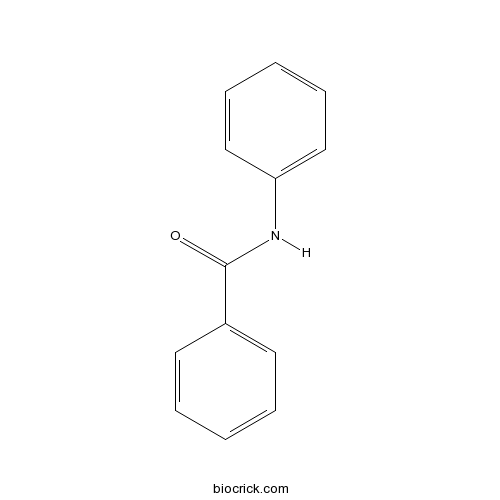BenzanilideCAS# 93-98-1 |

Quality Control & MSDS
3D structure
Package In Stock
Number of papers citing our products

| Cas No. | 93-98-1 | SDF | Download SDF |
| PubChem ID | 7168 | Appearance | Powder |
| Formula | C13H11NO | M.Wt | 197 |
| Type of Compound | N/A | Storage | Desiccate at -20°C |
| Solubility | Soluble in Chloroform,Dichloromethane,Ethyl Acetate,DMSO,Acetone,etc. | ||
| Chemical Name | N-phenylbenzamide | ||
| SMILES | C1=CC=C(C=C1)C(=O)NC2=CC=CC=C2 | ||
| Standard InChIKey | ZVSKZLHKADLHSD-UHFFFAOYSA-N | ||
| Standard InChI | InChI=1S/C13H11NO/c15-13(11-7-3-1-4-8-11)14-12-9-5-2-6-10-12/h1-10H,(H,14,15) | ||
| General tips | For obtaining a higher solubility , please warm the tube at 37 ℃ and shake it in the ultrasonic bath for a while.Stock solution can be stored below -20℃ for several months. We recommend that you prepare and use the solution on the same day. However, if the test schedule requires, the stock solutions can be prepared in advance, and the stock solution must be sealed and stored below -20℃. In general, the stock solution can be kept for several months. Before use, we recommend that you leave the vial at room temperature for at least an hour before opening it. |
||
| About Packaging | 1. The packaging of the product may be reversed during transportation, cause the high purity compounds to adhere to the neck or cap of the vial.Take the vail out of its packaging and shake gently until the compounds fall to the bottom of the vial. 2. For liquid products, please centrifuge at 500xg to gather the liquid to the bottom of the vial. 3. Try to avoid loss or contamination during the experiment. |
||
| Shipping Condition | Packaging according to customer requirements(5mg, 10mg, 20mg and more). Ship via FedEx, DHL, UPS, EMS or other couriers with RT, or blue ice upon request. | ||

Benzanilide Dilution Calculator

Benzanilide Molarity Calculator
| 1 mg | 5 mg | 10 mg | 20 mg | 25 mg | |
| 1 mM | 5.0761 mL | 25.3807 mL | 50.7614 mL | 101.5228 mL | 126.9036 mL |
| 5 mM | 1.0152 mL | 5.0761 mL | 10.1523 mL | 20.3046 mL | 25.3807 mL |
| 10 mM | 0.5076 mL | 2.5381 mL | 5.0761 mL | 10.1523 mL | 12.6904 mL |
| 50 mM | 0.1015 mL | 0.5076 mL | 1.0152 mL | 2.0305 mL | 2.5381 mL |
| 100 mM | 0.0508 mL | 0.2538 mL | 0.5076 mL | 1.0152 mL | 1.269 mL |
| * Note: If you are in the process of experiment, it's necessary to make the dilution ratios of the samples. The dilution data above is only for reference. Normally, it's can get a better solubility within lower of Concentrations. | |||||

Calcutta University

University of Minnesota

University of Maryland School of Medicine

University of Illinois at Chicago

The Ohio State University

University of Zurich

Harvard University

Colorado State University

Auburn University

Yale University

Worcester Polytechnic Institute

Washington State University

Stanford University

University of Leipzig

Universidade da Beira Interior

The Institute of Cancer Research

Heidelberg University

University of Amsterdam

University of Auckland

TsingHua University

The University of Michigan

Miami University

DRURY University

Jilin University

Fudan University

Wuhan University

Sun Yat-sen University

Universite de Paris

Deemed University

Auckland University

The University of Tokyo

Korea University
- 1-Phenylbutane-1,3-dione
Catalog No.:BCN3807
CAS No.:93-91-4
- Skimmin
Catalog No.:BCN4479
CAS No.:93-39-0
- Umbelliferone
Catalog No.:BCN4477
CAS No.:93-35-6
- Acetylisoeugenol
Catalog No.:BCN7075
CAS No.:93-29-8
- N-(2-Methoxyphenyl)acetamide
Catalog No.:BCC9054
CAS No.:93-26-5
- Methyl isoeugenol
Catalog No.:BCN8462
CAS No.:93-16-3
- Methyleugenol
Catalog No.:BCN4074
CAS No.:93-15-2
- Guaifenesin
Catalog No.:BCN2977
CAS No.:93-14-1
- 2-Acetonaphthone
Catalog No.:BCC8510
CAS No.:93-08-3
- 3,4-Dimethoxybenzoic acid
Catalog No.:BCN4475
CAS No.:93-07-2
- 3,4-Dimethoxybenzyl Alcohol
Catalog No.:BCN2721
CAS No.:93-03-8
- SGI-110
Catalog No.:BCC2221
CAS No.:929901-49-5
- Phenyl benzoate
Catalog No.:BCN8522
CAS No.:93-99-2
- Isosalvianolic Acid B
Catalog No.:BCC8330
CAS No.:930573-88-9
- R 59-022
Catalog No.:BCC7279
CAS No.:93076-89-2
- 8-O-Demethyl-7-O-methyl-3,9-dihydropunctatin
Catalog No.:BCN1307
CAS No.:93078-83-2
- Kaempferol 3-sophoroside-7-rhamnoside
Catalog No.:BCN1306
CAS No.:93098-79-4
- Enrofloxacin
Catalog No.:BCC4657
CAS No.:93106-60-6
- Ciprofloxacin hydrochloride
Catalog No.:BCC8915
CAS No.:93107-08-5
- (S,E)-Deca-2,9-diene-4,6-diyne-1,8-diol
Catalog No.:BCN1305
CAS No.:931114-98-6
- (R,E)-Deca-2-ene-4,6-diyne-1,8-diol
Catalog No.:BCN4476
CAS No.:931116-24-4
- Tacalcitol monohydrate
Catalog No.:BCC1976
CAS No.:93129-94-3
- IOX2(Glycine)
Catalog No.:BCC2229
CAS No.:931398-72-0
- PPQ-102
Catalog No.:BCC5248
CAS No.:931706-15-9
Novel Promising Estrogenic Receptor Modulators: Cytotoxic and Estrogenic Activity of Benzanilides and Dithiobenzanilides.[Pubmed:26730945]
PLoS One. 2016 Jan 5;11(1):e0145615.
The cytotoxicity of 27 Benzanilides and dithioBenzanilides built on a stilbene scaffold and possessing various functional groups in aromatic rings previously described for their spasmolytic properties was assayed on three human cancer cell lines (A549 -lung adenocarcinoma, MCF-7 estrogen dependent breast adenocarcinoma and MDA-MB-231 estrogen independent breast adenocarcinoma) and 2 non-tumorigenic cell lines (CCD39Lu-lung fibroblasts, MCF-12A - breast epithelial). Three compounds (6, 15 and 18) showed selective antiproliferative activity against estrogen dependent MCF-7 cancer cells and their estrogenic activity was further confirmed in MCF-7 transfected with an estrogen receptor reporter plasmid and in HEK239 cells over-expressing the estrogen receptor alpha (ERalpha). Compound 18 is especially interesting as a potential candidate for therapy since it is highly toxic and selective towards estrogen dependent MCF7 cell lines (IC50 = 5.07 muM versus more than 100 muM for MDA-MB-231) and almost innocuous for normal breast cells (IC50 = 91.46 muM for MCF-12A). Docking studies have shown that compound 18 interacts with the receptor in the same cavity as estradiol although the extra aromatic ring is involved in additional binding interactions with residue W383. The role of W383 and the extended binding mode were confirmed by site-directed mutagenesis.


